The Two-Part 'Rings of Power' Premiere Has Me in Absolute Awe
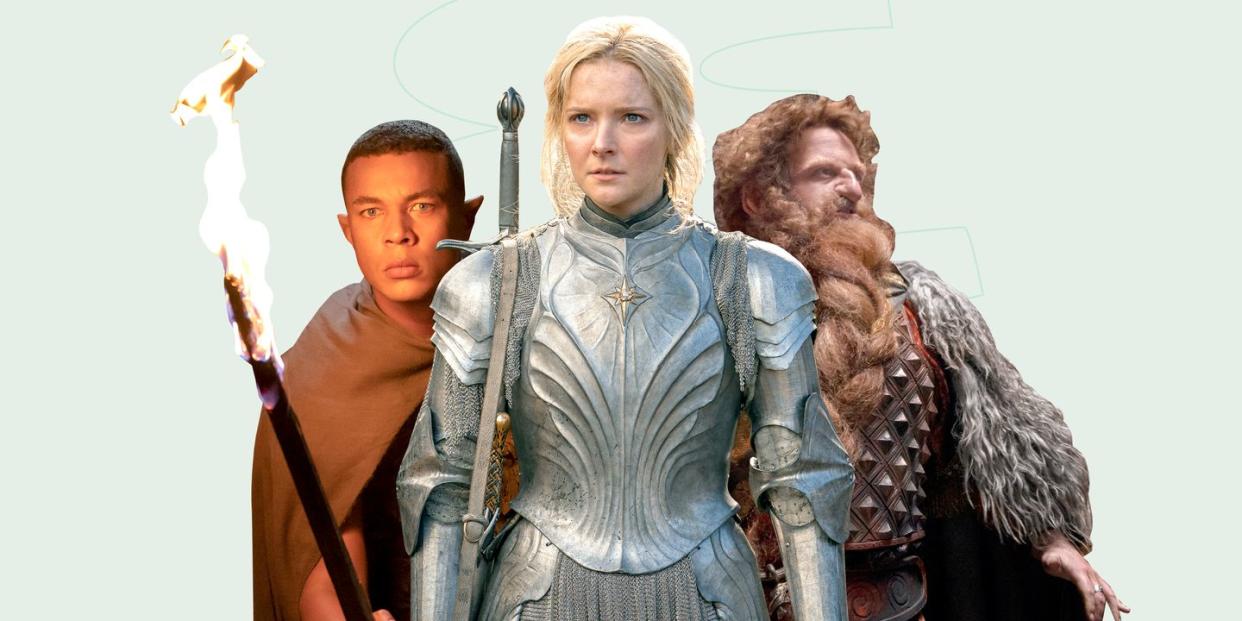
- Oops!Something went wrong.Please try again later.
In The Fellowship of the Ring, Bilbo Baggins wonders aloud, “Don’t adventures ever have an end? I suppose not. Someone else always has to carry on the story.”
Bilbo could almost be describing The Rings of Power, an outstanding example of how stories might live on without their original architects. In his robust appendixes to The Lord of the Rings, J.R.R. Tolkien sketched out a detailed chronology of Middle-earth’s Second Age, set thousands of years before The Lord of the Rings. Tolkien’s telling of events is extensive, but it’s not lived-in; it lacks the novelistic richness of his core legendarium, unfolding instead as a litany of battles, successions, and genealogical musings. This is exactly where Rings of Power merrily enters the picture, “wielding paint and music and drama,” as Tolkien himself might say.
Showrunners J.D. Payne and Patrick McKay have grafted more connective tissue onto Tolkien’s scaffolding, shading in the thoughts, feelings, and choices that propel these characters to each predetermined plot point. Their rendering of the Second Age is downright thrilling, breathing rich characterization, palm-sweating tension, and stirring thematic heft into the sparse source material. Where other franchises hold themselves hostage to canon, Rings of Power expands it without dishonoring Tolkien’s sandbox. We know where these characters are going, but their journeys are all the more meaningful for this richer understanding of where they’ve been.
Much ink has been spilled about how Rings of Power is the most expensive TV show of all time, with Prime Video set to spend a staggering $1 billion throughout its five confirmed seasons. Every last dime of that investment shows in the series’ lavish visual language, from breathtaking vistas to gorgeously (or gruesomely) rendered creatures. But that investment is also reflected in a love for the lore, right down to elaborate Dwarvish script on an axe or minute Elvish details in a character’s breastplate. Above all else, Rings of Power just feels like Tolkien should: mythic, sincere, sweeping, eternal. For newbies, it’s a portal to a life-changing legendarium, while for Tolkienheads, it’s like coming home.
Now that the first two episodes have aired, we’re breaking down what we’ve seen so far—including what we loved, what had us pointing excitedly at the screen, and what we’re still scratching our heads over.
And the Rings of Power Go To…
Galadriel
The unquestioned standout of these first two episodes is Morfydd Clark, who delivers a sensational interpretation of a seminal character. Her Galadriel is a far cry from the serene and sage Lady of Lorien we’ve met before—this Galadriel has fire in her belly and a spine of pure steel. Thousands of years younger and feistier than when we encounter her in The Lord of the Rings, she’s principled but uncompromising, ageless but impulsive, empathetic but isolated. Clark brings the sense of the eternal that makes Tolkien’s elves so compelling, along with a grief, restlessness, and steely conviction all Galadriel’s own.
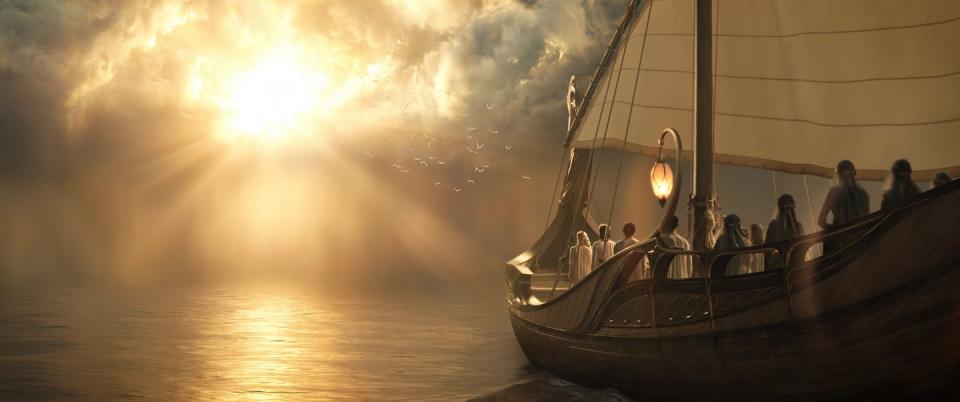
How about that holy-shit scene when Galadriel attains the heart’s desire of every elf and sails home to Valinor, only to jump overboard right before making landfall, then swim thousands of leagues back to Middle-earth? Ethereal and cosmic, bathed in heavenly light and gentle rain, it’s a beautiful, gobsmacking scene in its own right, but for Tolkienheads, it goes ten layers down. First off, rolling back the clouds to reveal a distant mirage of Valinor’s mysterious shores, only to bottle it all back up without a real lingering look, was the cruelest trick Payne and McKay could pull. Episode One and they’re already tormenting me! But the real triumph of this scene lies in how it expands Galadriel’s backstory. Readers of The Silmarillion know that a much-younger Galadriel was exiled from Valinor for her part in an Elven rebellion against the gods; centuries later, she was pardoned and invited to return, but refused the invitation. In Rings of Power, Elrond teases what’s to come when he exhorts Galadriel to sail, telling her, “No one in history has refused the call.” Sure, Rings of Power futzes with the timeline a bit, but this ultra-dramatic interpretation of Galadriel’s refusal is beautiful and shocking.
Durin and Disa
It’s boom times for Owain Arthur’s Durin IV, Prince of Durin’s Folk and future king of Khazad-dûm. Episode Two’s descent into Khazad-dûm is breathtaking—for the first time ever, Tolkien fans are glimpsing dwarven life in its age of splendor. That sweeping introductory shot of Khazad-dûm had me pausing the episode to peer closely at all the city’s intricate details. How about that eye-popping subterranean garden where dwarves till their crops in piercing shafts of white sunlight? As always, dwarves bring ribald comedy to the table, but in Durin, we have a different kind of dwarf—a proud and stubborn leader hiding a warm, gooey, touchy-feely center. And for the first time ever, we’re seeing dwarf women on screen! Created exclusively for Rings of Power, Durin’s wife Disa is clearly a force of nature. I love her already, even if Rings of Power chickened out on styling her with a luscious beard (yes, Tolkien’s dwarf gals had them too).
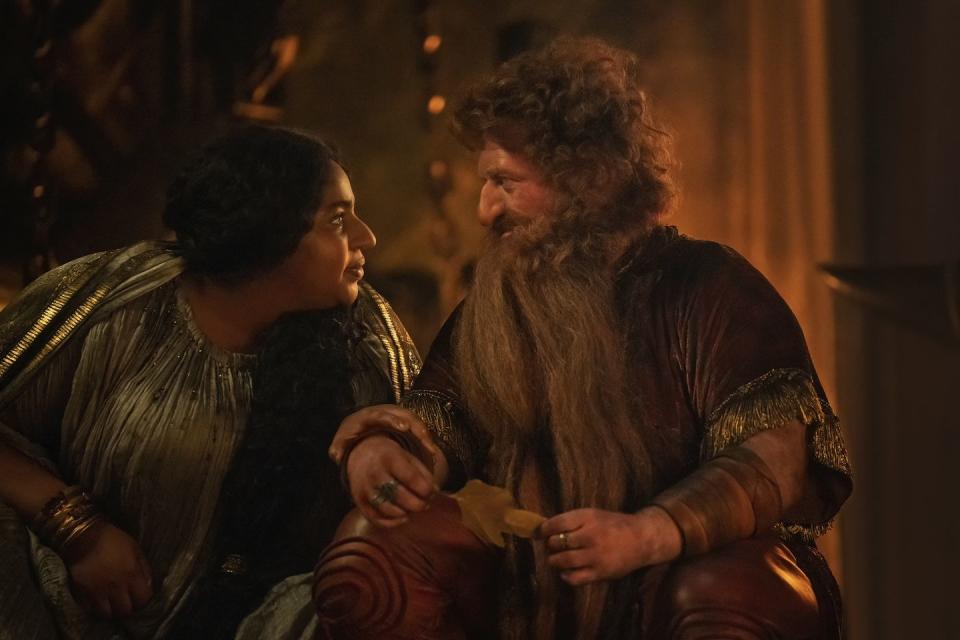
Elrond
The son of two heroes and the twin brother of the Númenor’s first king, Elrond has a hefty family inheritance on his shoulders—and an important future ahead of him as a key leader of the Second and Third Ages. But for now, he’s just a herald of High King Gil-galad, ghostwriting speeches and twisting his friends’ arms. What we’ve seen of Elrond thus far is a welcome sight for how it presages what lies ahead. Tolkienheads know that by the end of the Second Age, Elrond will found Rivendell, a refuge from Sauron where weary travelers of all races can find sanctuary. But before he steps into his future as a legendary statesman with a gift for building consensus between races, it seems only right that the Elrond of today should be negotiating an alliance between elves and dwarves. When Elrond realizes that his immortal ways have offended his mortal buddy Durin, it’s almost as if we see him filing away an important lesson for the future.
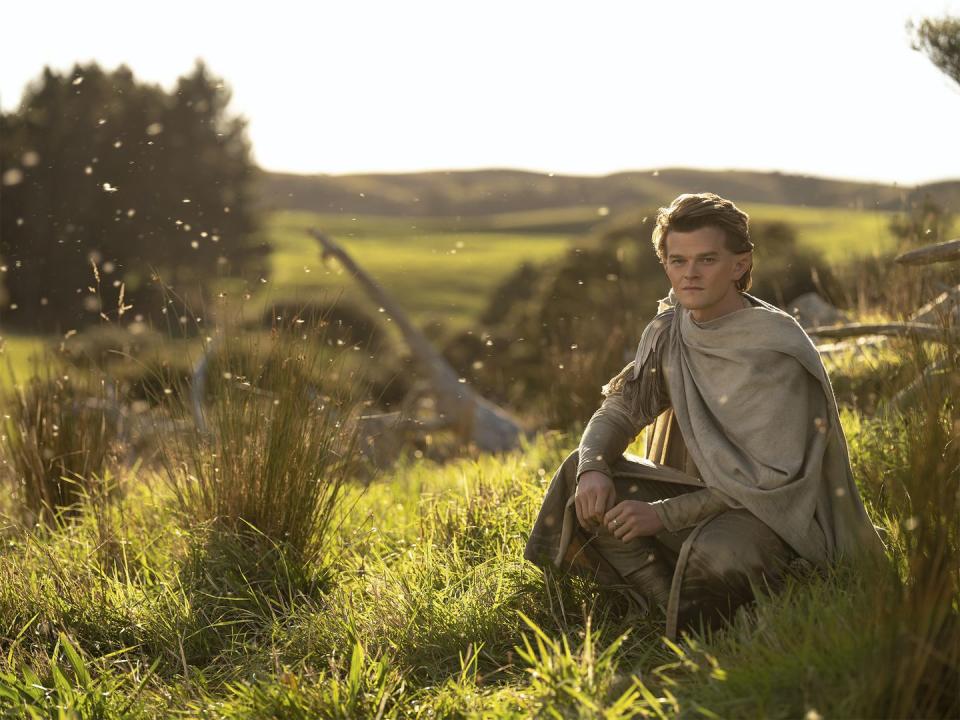
Arondir
The introduction of Ismael Cruz Córdova as the first person of color to play one of Tolkien’s elves is an electric moment in fantasy history. As Córdova tells Esquire, “You can never use it as an excuse: ‘But elves don’t look like that.’ They didn’t, but now they do.” Thus far, his Silvan soldier is a man of mystery, but I’m loving Arondir’s grace and quiet strength. And at just two episodes in, his sub-plot is already one of the most heart-pounding, what with all the forbidden romance and grave danger. Here’s hoping that next week, we find out who captured Arondir in that jump scare at the end of Episode Two (my money is on orcs—those hands on his shoulders looked awfully slimy).
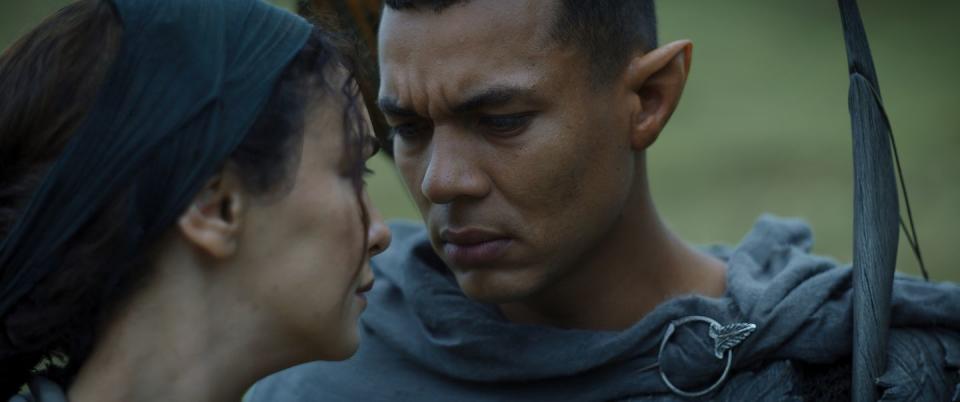
By Durin’s Beard, What Was That?
The Stranger
Who the hell is this troublesome superpowered stranger causing headaches for our lovable new Harfoot duo, Nori and Poppy? Indulge me in three theories:
For the first five centuries of the Second Age, not much was known about Sauron’s whereabouts. Could The Stranger be Sauron disguised as a doddering old man, with his descent to Earth by way of a meteor just another of his many deceptions? Certainly there are plenty of clues: The Stranger’s flaming crater looks an awful lot like the Eye of Sauron, and the tone of his scenes—withering wildlife, ominous whispers—suggests an air of malice. But here’s the problem: given that Sauron’s main priorities during the Second Age were corrupting men and deceiving elves, what would he want with Harfoots? These geopolitically irrelevant creatures would seem to rate far beneath his notice. Then again, as Tolkien often reminds us, plenty of people have lost their heads betting against the little guys.
Could The Stranger be Gandalf? He certainly has the right look, but that wouldn’t quite make sense, given that Gandalf didn’t roll into Middle-earth until the Third Age, when he and his fellow wizards arrived on a boat to assist in the fight against Sauron. But before Gandalf and his company were wizards, they were Maiar (primordial helpmeets of the gods who took many forms). Known to the gods and his fellow Maiar as Olórin, proto-Gandalf had a special concern for Middle-earth and knocked around its lands for thousands of years, mingling incognito among the elves to watch over them. By that logic, perhaps Rings of Power is taking some creative liberties with Gandalf’s earlier wanderings. This formative time with the Harfoots would certainly explain a lot about the affinity he’d later develop for hobbits. Or perhaps The Stranger is a different wizard entirely—in his thin sketches of the Blue Wizards, Tolkien often flip-flopped the timing, but in one telling, they arrived in Middle-earth during the Second Age to disrupt Sauron’s evil activities.
Hear me out on my wackiest theory: what if The Stranger is Glorfindel, the legendary Elven hero of old? At the end of the First Age, Glorfindel died heroically while slaying a Balrog. During the Second Age, he was re-embodied by the gods and sent back to Middle-earth to aid Elrond and Gil-galad in the fight against Sauron. Sure, he came by way of the sea in his beautiful Elven form, but maybe Rings of Power is taking some liberties. And if his meteor ended up in Harfoot territory rather than Elrond’s backyard… well, meteors are notoriously hard to steer.
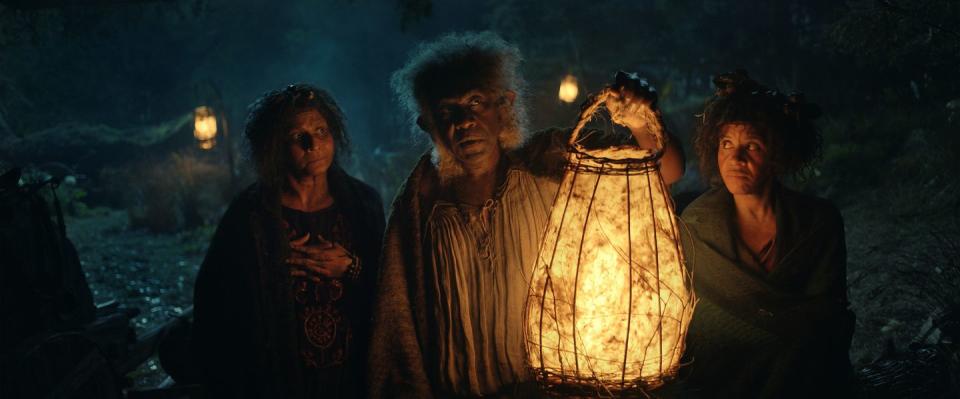
What’s in the Box, Durin?
When Prince Durin IV and his father King Durin III have a strategy sesh at the end of Episode Two, it’s clear that the dwarves of Khazad-dûm are keeping a secret from the elves. The secret is stored in a wooden box; when opened, we can’t see what’s inside, but its contents cast a white glow on the dwarves’ faces. The secret has got to be mithril, right? Canonically speaking, we know that the dwarves discovered this rare and valuable metal beneath the Misty Mountains during the Second Age. Trading mithril would later bond the dwarves of Khazad-dûm and the elves of nearby Eregion; Celebrimbor, who we meet in Episode Two, would even craft one of the three Elven Rings of Power from mithril. With the Forging of the Rings set to be a major part of the series’ architecture, I’m betting all my chips on this mithril hypothesis.
Sights More Beautiful Than the Silmarils
Two Easter eggs to cheer about this week, and they’re both blink-and-you-missed it glimpses of some Very Important Trees. In Episode One’s mythic prologue narrated by Galadriel, we caught a peek of Laurelin and Telperion, the otherworldly trees that brought light to Valinor during ancient times, long before the gods created the sun and the moon. Then, at the end of Episode One, we see Ents stirring in the forest as The Stranger’s meteor plunges to Earth. Give me Entwives next and I can die happy. After all, if we’re finally getting female dwarves, why not female Ents?
Could next week’s episode introduce us to Númenor’s Nimloth, the other Very Important Tree set to figure into this story? Stick with us week to week for more Rings of Power coverage—the unexpected journey is just getting started.
You Might Also Like

